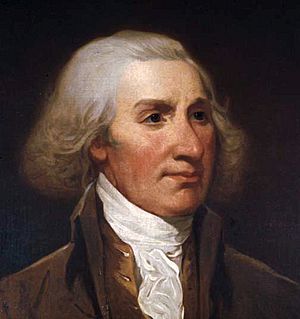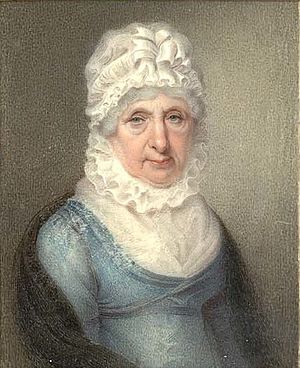Philip Schuyler facts for kids
Philip John Schuyler (November 20, 1733 – November 18, 1804) was an important American general during the American Revolutionary War. He also served as a United States Senator for New York. People usually call him Philip Schuyler, while his son is known as Philip J. Schuyler.
Born in Albany, New York, into a wealthy family, Schuyler fought in the French and Indian War. He was elected to the New York General Assembly in 1768 and to the Continental Congress in 1775. He helped plan the Continental Army's 1775 invasion of Quebec, but he had to give command to Richard Montgomery because he was not well. He also prepared the Continental Army's defense for the 1777 Saratoga campaign. However, he was replaced by Major General Horatio Gates before the main battles. Schuyler left the Continental Army in 1779.
After the war, Schuyler served in the New York State Senate for many years. He strongly supported the United States Constitution. He was elected to the 1st United States Congress as a Senator for New York. Later, he was elected to the Senate again in 1797 as a member of the Federalist Party. He resigned the next year due to poor health. Philip Schuyler was the father of Elizabeth Schuyler Hamilton and the father-in-law of Secretary of the Treasury Alexander Hamilton.
Quick facts for kids
Philip Schuyler
|
|
|---|---|
 |
|
| United States Senator from New York |
|
| In office March 4, 1797 – January 3, 1798 |
|
| Preceded by | Aaron Burr |
| Succeeded by | John Sloss Hobart |
| In office July 16, 1789 – March 3, 1791 |
|
| Preceded by | Office established |
| Succeeded by | Aaron Burr |
| 1st Surveyor General of New York | |
| In office March 30, 1781 – May 13, 1784 |
|
| Preceded by | Office established |
| Succeeded by | Simeon De Witt |
| Personal details | |
| Born |
Philip Schuyler
November 20, 1733 Albany, Province of New York, British America |
| Died | November 18, 1804 (aged 70) Albany, New York, U.S. |
| Resting place | Albany Rural Cemetery |
| Political party | Pro-Administration, Federalist |
| Spouse |
Catherine Van Rensselaer
(m. 1755; died 1803) |
| Children | |
| Parents | Johannes Schuyler, Jr. Cornelia van Cortlandt |
| Relatives | See Schuyler family |
| Profession | Soldier, Statesman |
| Military service | |
| Allegiance | Province of New York United States |
| Branch/service | New York Provincial Troops New York Colonial Militia Continental Army |
| Rank | Captain (NY) Colonel (NY) Major general (USA) |
| Battles/wars | French and Indian War Revolutionary War |
Early Life and Military Service
Growing Up in New York
Philip John Schuyler was born on November 20, 1733, in Albany, New York. His parents were Cornelia Van Cortlandt and Johannes Schuyler Jr. His family was one of the oldest and wealthiest Dutch families in America.
Before his father passed away when Philip was almost eight, he went to public school in Albany. After that, he was taught by private tutors at his family's estate in New Rochelle, New York. Philip learned both Dutch and English from a young age. He also studied French and math. While growing up, he joined many trade trips. This allowed him to meet Iroquois leaders and learn to speak the Mohawk language.
Joining the French and Indian War
In 1755, Schuyler joined the British forces during the French and Indian War. He raised a local company of soldiers and became their captain. In 1756, he worked with British officer Colonel John Bradstreet. He gained experience as a quartermaster, which means he was in charge of supplying the army. He took part in several battles, including Lake George and Fort Frontenac.
After the war, Schuyler traveled to England to help settle some financial claims. He stayed there from 1760 to 1763. When he returned to America, he managed several farms and businesses in upstate New York. He also built the first flax mill in the American colonies. In 1767, Schuyler became a colonel and commander of a militia regiment. The next year, in 1768, he served as a member of the New York Assembly.
Role in the American Revolution
Serving in the Continental Congress
In 1775, Philip Schuyler was chosen to be a member of the Continental Congress. This was the group of representatives from the American colonies. He served there until he was made a major general in the Continental Army in June of that year.
General Schuyler took command of the Northern Department of the army. He helped plan the invasion of Quebec. However, because of his poor health, he had to give command of the invasion to Richard Montgomery. In 1777, he served in the Continental Congress again.
The Saratoga Campaign
Schuyler returned to lead the Northern Department in 1777. He worked hard to prepare defenses against the British Saratoga campaign. This was a plan by the British to split the American colonies in two by taking over New York State.
In the summer of 1777, British General John Burgoyne marched his army south from Quebec. He captured Fort Ticonderoga. When General Arthur St. Clair gave up Fort Ticonderoga in July, the Continental Congress replaced Schuyler. They put General Horatio Gates in charge instead. Gates had accused Schuyler of not doing his duty. In 1778, Schuyler and St. Clair were investigated for the loss of Ticonderoga, but they were both found innocent.
The British attack was eventually stopped by the Continental Army. This army was then led by Gates and Benedict Arnold in the Battles of Saratoga. This American victory was very important. It was the first time a large British force was completely defeated. This win convinced France to join the war and help the Americans. Schuyler later asked for a military trial to clear his name from Gates's accusations. He was proven right and resigned from the army on April 19, 1779. He then served in the Continental Congress two more times in 1779 and 1780.
Later Life and Political Career
After the Revolutionary War
As a well-known politician and Patriot leader in New York, Schuyler was once targeted for kidnapping. This happened on August 7, 1781, but Schuyler was able to leave his Albany home before the kidnappers arrived.
After the war, Schuyler expanded his estate in Saratoga. He added more land, businesses, and mills for flour, flax, and lumber. He also built several ships on the Hudson River.
Serving in Government
Philip Schuyler was a member of the New York State Senate from 1780 to 1784. At the same time, he was also the Surveyor General of New York from 1781 to 1784. He returned to the State Senate from 1786 to 1790. During this time, he strongly supported the adoption of the United States Constitution.
In 1789, he was elected as a U.S. Senator from New York to the 1st United States Congress. He served from July 27, 1789, to March 3, 1791. He lost his re-election bid in 1791 to Aaron Burr. Schuyler then returned to the State Senate from 1792 to 1797. In 1797, he was chosen again to be a U.S. Senator. He served from March 4, 1797, until he resigned on January 3, 1798, because of poor health.
Family Life
On September 7, 1755, Philip Schuyler married Catherine Van Rensselaer (1734–1803) in Albany. Catherine was from another important family in New York. Philip and Catherine had 15 children together, but only eight of them lived to adulthood. Some of their notable children include:
- Angelica Schuyler (1756–1814), who married John Barker Church.
- Elizabeth Schuyler (1757–1854), who married Alexander Hamilton. Elizabeth also helped start the first private orphanage in New York City.
- Margarita "Peggy" Schuyler (1758–1801), who married Stephen Van Rensselaer III.
- Philip Jeremiah Schuyler (1768–1835), who served in the United States House of Representatives.
- Catherine Van Rensselaer Schuyler (1781–1857).
Schuyler's country home was destroyed by British forces in October 1777. He began rebuilding on the same spot later that year. This home is now part of the Saratoga National Historical Park and is open to the public.
Philip Schuyler passed away at his home, the Schuyler Mansion in Albany, on November 18, 1804. This was just four months after his son-in-law, Alexander Hamilton, died in a duel. Schuyler is buried at Albany Rural Cemetery in Menands, New York.
Legacy and Recognition
Places Named After Schuyler
Many places are named in honor of Philip Schuyler, including:
- Schuyler, New York
- Schuylerville, New York
- Schuyler County, New York, as well as counties in Illinois and Missouri.
- Fort Schuyler, a military fort in the Bronx, New York.
Art and Statues
Philip Schuyler was shown in a painting by John Trumbull in 1821 called Surrender of General Burgoyne. This painting is in the United States Capitol rotunda in Washington, D.C.
A bronze statue of Philip Schuyler was put up outside Albany City Hall in 1925. In 2020, the mayor of Albany decided to have the statue removed. This was because Schuyler owned slaves. The mayor of Schuylerville, New York, then asked for the statue to be moved to the Schuyler House in their town.
Images for kids
-
Schuyler Mansion, which was built from 1761 to 1765.
-
Schuyler's Country House used during the Revolution, in Schuylerville.
See also
 In Spanish: Philip Schuyler para niños
In Spanish: Philip Schuyler para niños




